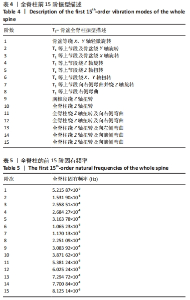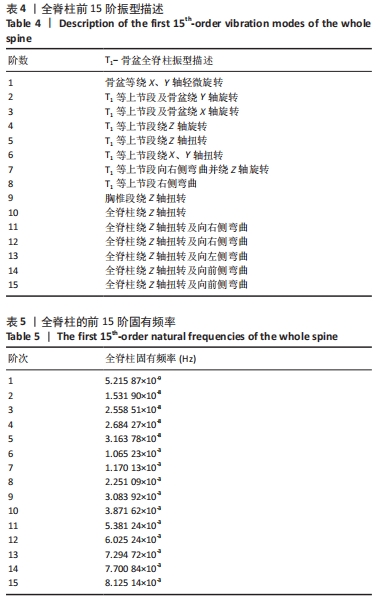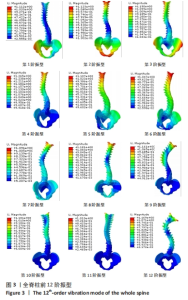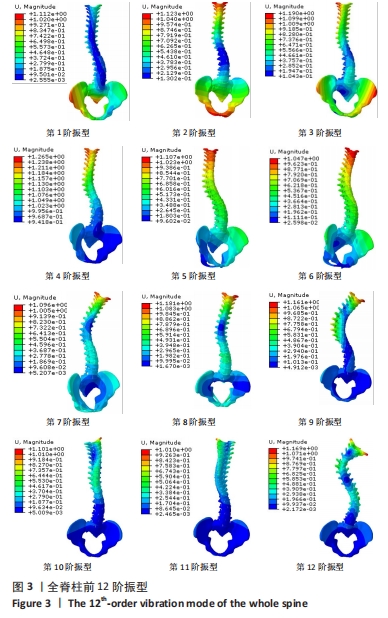[1] RIGO M, JELAČIĆ M. Brace technology thematic series: the 3D Rigo Chêneau-type brace. Scoliosis Spinal Disord. 2017;12:10.
[2] HAN J, XU Q, YANG Y, et al. Evaluation of quality of life and risk factors affecting quality of life in adolescent idiopathic scoliosis. Intractable Rare Dis Res. 2015;4(1):12-16.
[3] ROLTON D, NNADI C, FAIRBANK J. Scoliosis: a review. Paed Child Healt-Can. 2014;24(5):197-203.
[4] ASHER MA, BURTON DC. Adolescent idiopathic scoliosis: natural history and long term treatment effects. Scoliosis. 2006;1(1):2.
[5] 李现政,富荣昌,吴辉,等.Lenke3型特发性侧凸脊柱的动态特性[J].医用生物力学,2022,37(4):638-643.
[6] 项嫔,都承斐,赵美雅,等.全腰椎有限元模态分析[J].医用生物力学,2014,29(2):154-160.
[7] BOSHUIZEN HC, BONGERS PM, HULSHOF CT. Self-reported back pain in fork-lift truck and freight-container tractor drivers exposed to whole-body vibration. Spine (Phila Pa 1976). 1992;17(1):59-65.
[8] SHOJAEI I, SALT EG, HOOKER Q, et al. Mechanical demands on the lower back in patients with non-chronic low back pain during a symmetric lowering and lifting task. J Biomech. 2018;70:255-261.
[9] FAN W, ZHAO D, GUO LX. A finite element model of the human lower thorax to pelvis spinal segment: Validation and modal analysis. Biomed Mater Eng. 2021;32(5):267-279.
[10] GOEL VK, PARK H, KONG W. Investigation of vibration characteristics of the ligamentous lumbar spine using the finite element approach. J Biomech Eng. 1994;116(4):377-383.
[11] XU M, YANG J, LIEBERMAN I, et al. Finite element method-based study for effect of adult degenerative scoliosis on the spinal vibration characteristics. Comput Biol Med. 2017;84:53-58.
[12] FAN W, GUO LX. Influence of different frequencies of axial cyclic loading on time-domain vibration response of the lumbar spine: A finite element study. Comput Biol Med. 2017;86:75-81.
[13] WANG QD, GUO LX. Biomechanical Role of Nucleotomy in Vibration Characteristics of Human Spine. Int J Precis Eng Man. 2021;22(11): 1323-1334.
[14] 王庆东,郭立新,张驰,等.不同椎间融合方法对腰椎动态特性的影响[J].东北大学学报(自然科学版),2022,43(1):76-82.
[15] LI XF, LIU ZD, DAI LY, et al. Dynamic response of the idiopathic scoliotic spine to axial cyclic loads. Spine (Phila Pa 1976). 2011;36(7):521-528.
[16] WILDER DG, POPE MH. Epidemiological and aetiological aspects of low back pain in vibration environments - an update. Clin Biomech (Bristol, Avon). 1996;11(2):61-73.
[17] 范威,张驰,王庆东,等.振动载荷下不同入路腰椎椎间融合术的生物力学研究[J].生物医学工程学杂志,2021,38(5):877-884.
[18] KASRA M, SHIRAZI-ADL A, DROUIN G. Dynamics of human lumbar intervertebral joints. Experimental and finite-element investigations. Spine (Phila Pa 1976). 1992;17(1):93-102.
[19] BAZRGARI B, SHIRAZI-ADL A, KASRA M. Seated whole body vibrations with high-magnitude accelerations--relative roles of inertia and muscle forces. J Biomech. 2008;41(12):2639-2646.
[20] 武晓丹,张顺心,范顺成,等.三维有限元分析腰骶椎结构的动态特性[J].中国组织工程研究,2017,21(15):2388-2394.
[21] LIN L, JIA S, YANG H, et al. Influence of Rib Cage on Static Characteristics of Scoliotic Spine. Appl Bionics Biomech. 2020;2020:8858686.
[22] GUAN T, ZHANG Y, ANWAR A, et al. Determination of Three-Dimensional Corrective Force in Adolescent Idiopathic Scoliosis and Biomechanical Finite Element Analysis. Front Bioeng Biotechnol. 2020;8:963.
[23] BROWN N, SAPUTA C, BLACK J. Young’s modulus of living human boneTransactions of the Orthopaedic Research Society. The 27th Annual Meeting of the Orthopaedic Research Society. 1981.
[24] SHARMA M, LANGRANA NA, RODRIGUEZ J. Role of ligaments and facets in lumbar spinal stability. Spine (Phila Pa 1976). 1995;20(8):887-900.
[25] ROBERTS SB, CHEN PH. Elastostatic analysis of the human thoracic skeleton. J Biomech. 1970;3(6):527-545.
[26] CLIN J, AUBIN CÉ, PARENT S, et al. Biomechanical modeling of brace treatment of scoliosis: effects of gravitational loads. Med Biol Eng Comput. 2011;49(7):743-753.
[27] PÉRIÉ D, AUBIN CE, PETIT Y, et al. Personalized biomechanical simulations of orthotic treatment in idiopathic scoliosis. Clin Biomech (Bristol, Avon). 2004;19(2):190-195.
[28] WANG H. Development of a side impact finite element human thoracic model. Wayne State University, 1995.
[29] 肖智韬.基于非线性有限元法的人体腰椎强度预测及其在腰椎相关疾病中的应用[D].长春:吉林大学,2013.
[30] 杨虎飞.胸廓对侧凸脊柱静动态特性影响的研究[D].石家庄:河北工业大学,2019.
[31] 张玉芳,吕蒙,梅钊.青少年脊柱侧弯全脊柱生物力学模型的构建及验证[J].中国组织工程研究,2022,26(9):1351-1356.
[32] JIA S, LI Y, XIE J, et al. Differential response to vibration of three forms of scoliosis during axial cyclic loading: a finite element study. BMC Musculoskelet Disord. 2019;20(1):370.
[33] 刘杰,范若寻,高甲子,等.有限元法分析车辆低频振动时不同退变程度人体腰椎的力学响应[J].中国组织工程研究,2020,24(9): 1371-1377.
[34] 杨虎飞,林丽滢,张顺心,等.胸廓对侧凸脊柱动态响应稳定性的影响[J].生物医学工程学杂志,2019,36(5):769-776.
[35] CHAMAY A, TSCHANTZ P. Mechanical influences in bone remodeling. Experimental research on Wolff’s law. J Biomech. 1972;5(2):173-180.
|



